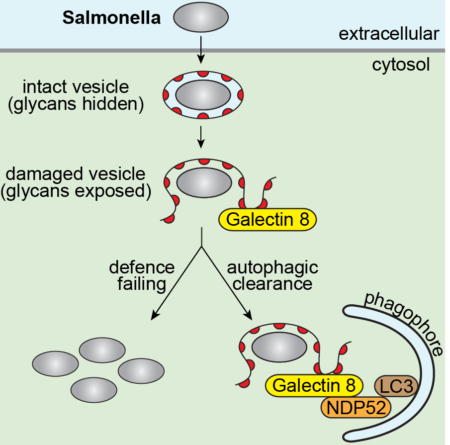

We are interested in cell autonomous innate immunity, i.e. in the ability of individual cells to defend themselves against infection.

Cytosolic defence against bacterial invasion
The mammalian cytosol is rich in nutrients but can be colonized by specialized bacteria only. We therefore wish to understand i) how cells succeed in defending their cytosol against most invasion attempts and ii) how professional cytosol dwelling bacteria outwit cellular defences. We are particularly interested in danger receptors that detect breaches in cellular integrity, and in the ubiquitin system that marks invading bacteria as cargo for autophagy receptors.
Regulation of NF-?B and IRF signalling
The defence against pathogens requires profound changes in gene expression that are coordinated by latent transcription factors of the NF-kB and IRF families. We aim to understand how infection activates NF-?B and IRF signalling.
Somatic cell genetics
The genetic analysis of somatic cell lines holds significant potential for our understanding of signal transduction and other cell autonomous traits. We use haploid cells, CRISPR technology, and chemical mutagenesis to isolate genes governing the interaction between pathogens and host cells.
Selected Papers
- Otten, E.G., Werner, E., Crespillo-Casado, A., Boyle, K.B., Dharamdasani, V., Pathe, C., Santhanam, B., and Randow, F. (2021)
Ubiquitylation of lipopolysaccharide by RNF213 during bacterial infection
Nature 594: 111-116. - Wandel, M.P., Kim, B.-H., Park, E.-S., Boyle, K.B., Nayak, K., Lagrange, B., Herod, A., Henry, T., Zilbauer, M., Rohde, J., MacMicking, J., Randow, F. (2020)
Guanylate-binding proteins convert cytosolic bacteria into caspase-4 signaling platforms
Nat Immunol 20(8): 1-12. - Ellison, C.J., Kukulski, W, Boyle, KB, Munro, S., Randow, F. (2020)
Transbilayer movement of sphingomyelin precedes catastrophic breakage of enterobacteria-containing vacuoles
Current Biology 30: 1-10. - Ravenhill BJ, Boyle KB, von Muhlinen N, Ellison CJ, Masson GR, Otten EG, Foeglein A, Williams R, Randow F. (2019)
The cargo receptor NDP52 initiates selective autophagy by recruiting the ULK complex to cytosol-invading bacteria.
Mol. Cell 74(2): 320-329. - Wandel, M., Pathe, C., Werner, E., Ellison, C., Boyle, K., Rohde, J., Randow, F. (2017)
GBPs inhibit motility of Shigella flexneri but are targeted for degradation by the bacterial ubiquitin ligase IpaH9.8.
Cell Host and Microbe 22: 5-7-518. - Noad, J., Malsburg, von der, A., Pathe, C., Michel, M.A., Komander, D., and Randow, F. (2017)
LUBAC-synthesized linear ubiquitin chains restrict cytosol-invading bacteria by activating autophagy and NF-κB.
Nat. Microbiol 2: 17063. - Thurston TL, Boyle KB, Allen M, Ravenhill BJ, Karpiyevich M, Bloor S, Kaul A, Noad J, Foeglein A, Matthews SA, Komander D, Bycroft M, Randow F. (2016)
Recruitment of TBK1 to cytosol-invading Salmonella induces WIPI2-dependent antibacterial autophagy.
EMBO J. 35: (16):1779-92. - Beale, R., Wise, H., Stuart, A., Ravenhill, B.J., Digard, P., and Randow, F. (2014)
A LC3-interacting motif in the influenza A virus M2 protein is required to subvert autophagy and maintain virion stability.
Cell Host and Microbe 15: 239–247. - Randow, F., MacMicking, J.D., and James, L.C. (2013)
Cellular self-defense: How cell-autonomous immunity protects against pathogens.
Science 340: 701–706. - Thurston, T.L.M., Wandel, M.P., Muhlinen, Von, N., Foeglein, Á., and Randow, F. (2012)
Galectin 8 targets damaged vesicles for autophagy to defend cells against bacterial invasion.
Nature 482: 414–418. - Muhlinen, von, N., Akutsu, M., Ravenhill, B.J., Foeglein, A., Bloor, S., Rutherford, T.J., Freund, S.M.V., Komander, D., and Randow, F. (2012)
LC3C, Bound Selectively by a Noncanonical LIR Motif in NDP52, Is Required for Antibacterial Autophagy
Molecular Cell 48: 329–342. - Bloor, S., Maelfait, J., Krumbach, R., Beyaert, R. and Randow, F. (2010)
Endoplasmic reticulum chaperone gp96 is essential for infection with vesicular stomatitis virus.
Proc Natl Acad Sci U S A 107: 6970-6975. - Thurston, T.L., Ryzhakov, G., Bloor, S., von Muhlinen, N. and Randow, F. (2009)
The TBK1 adaptor and autophagy receptor NDP52 restricts the proliferation of ubiquitin-coated bacteria.
Nat Immunol 10: 1215-1221.
Group Members
- Keith Boyle
- Alexander Heatley
- Yu Heng Hew
- Paul Lehner
- Briac Lemetais
- Thomas Mund
- Katerina Naydenova
- Prathyush Pothukuchi
- Marcel Rühling
- Felix Scharte
- Emily Schierig
- George Winder
- Chi Jie Matthew Yip